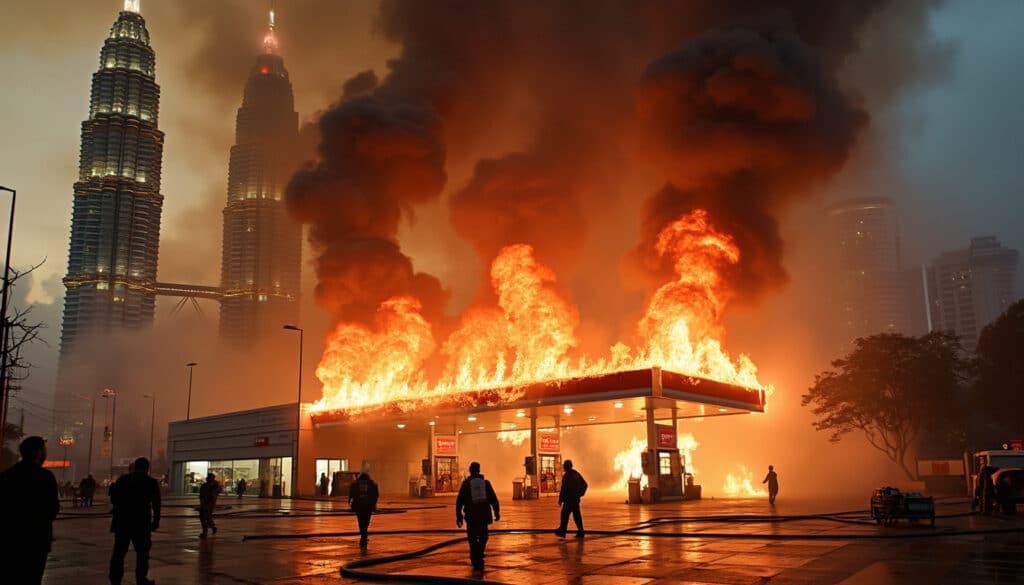A colossal fire broke out in a Malaysian suburb near Kuala Lumpur following the rupture of a gas pipeline.
The inferno, located in Putra Heights in the central state of Selangor, was visible for miles around.
The national oil company Petronas confirmed that the fire started at 8:10 AM.
The fire led to the evacuation of nearby homes, while rescue teams worked tirelessly to control the flames. Three gas stations close to the site were temporarily closed as a precaution. Several residents sustained injuries and are receiving treatment. Authorities continue to assess the extent of the damage caused by this tragedy.
A colossal fire broke out on Tuesday morning in the suburb of Putra Heights, on the outskirts of Kuala Lumpur, after the rupture of a gas pipeline owned by the national company Petronas. The explosion, which occurred at 8:10 AM, quickly turned the area into chaos, visible for several kilometers.
What were the causes of the gas explosion?
The fire was triggered by a rupture of the gas pipeline, according to Petronas. The company indicated that the affected pipeline was immediately isolated to limit the damage. However, the exact cause of the rupture is still under investigation. Experts are currently examining whether factors such as corrosion, manufacturing defects, or operational errors may have contributed to this incident.
What were the immediate impacts on the local community?
The explosion had devastating consequences for the residents of the area. Several neighboring houses were affected by the flames, forcing local authorities to order a rapid evacuation. Evacuated residents were temporarily housed in a nearby mosque while rescue teams worked to control the fire and rescue trapped individuals.
According to the Selangor disaster management department, seven people were rescued by fire crews, and several others sustained burns requiring medical care. The total extent of material damage is still being assessed, but authorities assured that the pipeline valve has been closed, which should eventually extinguish the fire.
How is Petronas managing the crisis?
Petronas reacted swiftly by isolating the affected pipeline and temporarily closing three nearby gas stations as a precaution. The company released a brief but clear statement indicating that investigations are ongoing to determine the exact causes of the fire.
Furthermore, Petronas is closely collaborating with local authorities and rescue teams to ensure an effective response to the crisis. The company has also promised to provide support to the victims and take necessary measures to prevent similar future incidents.
What prevention measures are being considered to avoid future fires?
Following this incident, it is likely that Petronas and local authorities will strengthen security measures concerning gas transport infrastructures. Possible actions may include more rigorous inspections of pipelines, the use of advanced technologies to detect gas leaks, and enhanced training for operators.
In addition, integrating new databases could improve fire management strategies, as highlighted in this article on Green Just Now. Continuous monitoring and the adoption of innovative technologies are essential to prevent such disasters in the future.
What is the impact of this fire on the renewable energy sector?
Incidents like the one in Putra Heights highlight the ongoing challenges associated with the use of fossil fuels. As renewable energy gains importance, tragic events underscore the need for a faster transition to safer and more sustainable energy sources.
As a professional in wind energy, I believe these incidents bolster the case for renewable energies. Dependence on fossil fuels not only poses environmental risks but also immediate dangers to local communities.
To learn more about the climate implications of continued fossil fuel use, check out this article on Green Just Now.
What is the public and media reaction to this fire?
The explosion and fire quickly attracted media and social media attention. Videos and photos showing the extent of the fire circulated on platforms, causing a shock both locally and internationally. Some residents reported feeling the tremors of the explosion, indicating the violence of the incident.
Public reactions have been mixed between concern for energy security and disappointment at Petronas’s crisis management. Many are calling for greater transparency and stricter prevention measures to avoid such disasters in the future.
What lessons can be learned from this disaster?
Each incident of this type offers valuable lessons for improving the safety and management of critical infrastructures. One of the main lessons is the necessity to maintain and modernize pipelines to avoid ruptures. The incident also highlights the importance of having effective evacuation plans and sufficient resources to respond quickly to emergencies.
Furthermore, this event reinforces the importance of renewable energy initiatives. The transition to cleaner energy sources could not only reduce the risk of accidents associated with fossil fuels but also significantly contribute to the fight against climate change.
To delve deeper into the economic challenges posed by climate shocks, this article from Green Just Now provides a detailed analysis.
What are the future perspectives for the region after the fire?
The Selangor region, affected by this disaster, now faces a crossroads. Reconstruction efforts will be essential to restore residents’ confidence and ensure infrastructure safety. Petronas, in collaboration with local authorities, will need to not only repair physical damage but also implement robust preventive measures.
Moreover, this incident could stimulate public debate on fossil fuel dependence and encourage further investments in renewable energies. By strengthening infrastructure resilience and adopting more sustainable practices, the region could position itself as a model for successful energy transition.
To learn more about forest fire management strategies, check out this article from Green Just Now.
Articles similaires
Thank you!
We will contact you soon.














